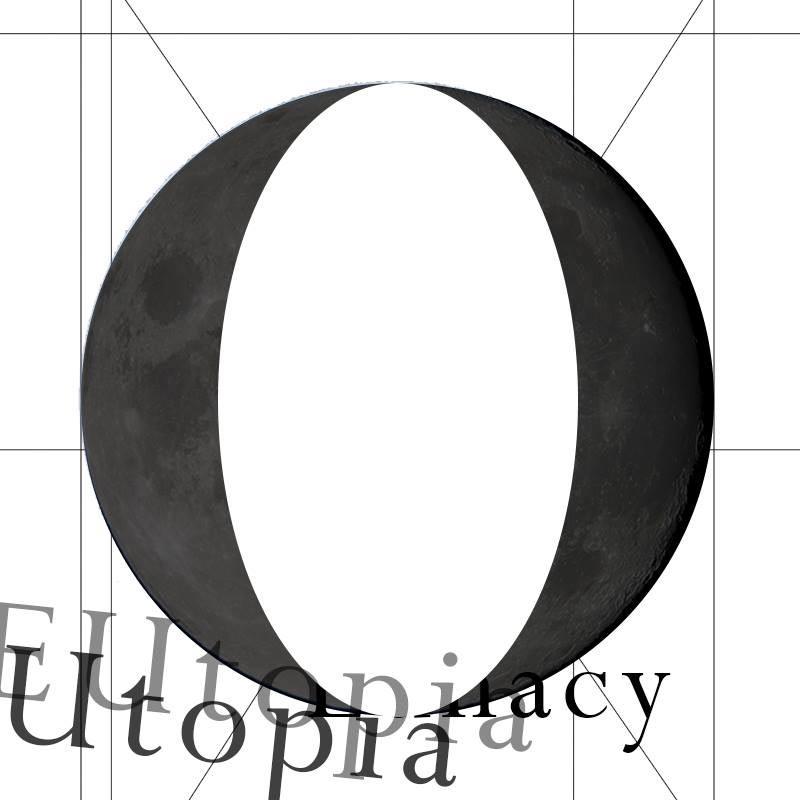
Hyperallergic
Delirious Architecture Filled with Fractal Trickery
By Seph Rodney, April 4, 2016
The old saying “God is in the details,” connoting that paying attention to small things can have great rewards, resonates powerfully in Laetitia Soulier’s The Fractal Architectures, now on view at Claire Oliver Gallery. There’s a rare quality of genuine wonder in these photographs and set models. When I visited the gallery to talk to the artist about her work, I saw people animatedly gazing into her Matryoshka Doll sculpture, talking to each other, pointing out particular features: the spiraling wooden staircase that winds through the work’s core, the tiny vanity with its art nouveau curves, the anthropomorphic clock shaped like the doll figures on the cardinal-red wallpaper that lines the entire room. The work is earnestly charming, but this endearing feel is achieved because it’s persnickety in its material details, layered in its meanings, and visually bountiful. You need to spend half an hour looking at one photograph to gather all of what’s happening inside it.
Laetitia Soulier, The Matryoshka Dolls Sculpture, 2015, Mixed Media, 48 x 72 x 34 inches | 122 x 183 x 86 cm, & The Matryoshka Dolls 3, C-Print, 40 x 80 inches | 102 x 203 cm The exhibition’s title references fractals, which, according to the Fractal Foundation, are “never-ending, infinitely complex patterns that are self-similar across different scales.” This comes into play with the mechanics of Soulier’s construction of the sets as documented in the large-scale color photographs that make up the larger part of the exhibition. It’s all repetition of objects and motifs — some beneath the threshold of easy notice. In “The Square Roots 3” (2016), the green wallpaper is a pattern of alternating nested boxes. The central figure in the scene, a young boy, sits on a cross-sectioned staircase that is also essentially a series of boxes within which are further elaborations on this theme: small rooms that contain square cubbyholes for books, a partially laid floor foundation that reveals a lattice of rectangles beneath it, a drawer spilling out building blocks. Even the boy’s belt contains the wallpaper’s pattern in reversed colors. The work rewards your looking: upon closer inspection, the fractal trickery seems to play out almost infinitely, making delight verge on delirium. Laetitia Soulier, The Square Roots 3, C-Print, 40 x 80 inches | 102 x 203 cm Soulier achieves her effects by playing with scale. Most of the photos feature models that vary between a one-to-one scale and one-twelfth scale. Like the matryoshka dolls, chambers are nested within rooms nested within other rooms. It takes Soulier several months to build these sets — in one case (“The Square Roots 3”) it took an entire year. Often the works include a glimpse of a child, a being more open to the imaginative adventures that adults tend to refuse, one who is always on the threshold of becoming something new and different. The child’s physical presence within the image frame and his metaphorical status as a liminal being helps to illustrate the paradoxical nature of Soulier’s worlds. The artist told me that she studied logic and epistemology, gravitating toward Lewis Carroll, creator of Alice’s Adventures in Wonderland, because with his paradoxes, Carroll pushes rationality into a corner. Laetitia Soulier, The Square Roots 1, C- Print, 40 x 80 inches | 102 x 203 cm The fractal interplay in these pieces focuses the viewer’s gaze, but there are other ideas percolating. In “Fractal Architectures: Square Roots 1” (2014), Soulier has included a tree at the basement level growing up right through the floorboards. It’s as if she’s saying that the natural world models endlessly proliferating cycles of growth that, like a child, will always grow out of carefully constructed frames. Soulier has created a unique set of visual enchantments that, as the poet Andrew Marvell wrote, “grow vaster than empires and more slow.” Laetitia Soulier, The Matryoshka Dolls Sculpture, 2015, Mixed Media, 48 x 72 x 34 inches | 122 x 183 x 86 cm Laetitia Soulier, The Square Roots Sculpture, 2015, Mixed Media, 51 x 39.5 x 39.5 inches | 129.54 x 100.33 x 100.33 cm Laetitia Soulier, The Matryoshka Dolls 3, C- Print, 40 x 80 inches | 102 x 203 cm Laetitia Soulier, The Matryoshka Dolls 2, C- Print, 40 x 80 inches | 102 x 203 cm


Eyes Towards The Dove
Laetitia Soulier’s Suspended Stories in Fractal Architecture
By Sarah Walko, April 25, 2016
Laetitia Soulier’s Suspended Stories in Fractal Architecture “All the world’s a stage and all the men and women merely players. They have their exits and their entrances and one man in his time plays many parts, his acts being several ages.” – William Shakespeare, As You like It, Act II, Scene VII. Exits, entrances, peep holes, rooms inside rooms, characters evolving through generations in one pictorial plane; these are the elaborate worlds inside the photographs and sculptures made by Laetitia Soulier in her recent exhibition Fractal Architectures at Claire Oliver. Each sculpture is a constructed set and each photograph is a staged activation of the sets. She uses the sets to play with scale, creating micro and macro worlds in the architecture and timeless layers in the narrative.

Laetitia Soulier, The Square Roots 3, C-Print, 40 x 80 inches | 102 x 203 cm
Laetitia Soulier, The Square Roots 3, detail, C-Print, 40 x 80 inches | 102 x 203 cm
Process and Pattern
Soulier’s process is as fascinating as the result, beginning with a research phase where she conceptualizes the series, deciding on a specific fractal geometric pattern and designs a wallpaper with that pattern. She uses the pattern as the basis for the architectural floor plan of each model and the creation of the furniture, makes a character for the set and builds it based on their qualities such as size, shape, and hair color. The set is also built from the perspective of the camera, which is on a stand during the entire construction. Page 2 of 18 Every single object in the photograph is built at the studio and once all the props are in place, she lights and photographs the set. Due to the very detailed quality of the architectural model and the large number of lights needed, she divides the photograph into sub-tableau and lights them independently before recomposing them in Photoshop. This last phase of post-production helps to nuance the colors and contrast of the image. The final photographs are large scale and all the images in one series are printed at the same time, so that the light and color dynamics are coherent throughout.
The repetition of fractals, also known as expanding or evolving symmetry, can be used for describing, measuring and predicting natural phenomena and defining the world using mathematical equations. Soulier uses this as her building blocks and then plays with subjective narrative in between this solid framework. An individual’s gravitation towards geometric patterns and the history of this in the collective unconscious in differing cultures also arises when viewing her work. The Swiss psychoanalyst Carl Jung pioneered exploration of the unconscious through research and his own art making. He wrote observations on the motif of the circle after he found himself drawing patterns of circles in his own artwork. Familiarity with the philosophical writings from India, Jung began to study the geometric patterns of the mandala and re-introduced them into modern Western thought. In Indian religions they are a spiritual and ritualistic symbol that represents the universe and serves the purpose of restoring a previously existing order; but it also serves the purpose of creatively giving expression and form to something that does not yet exist, something unique and new. Soulier’s work also references this unseen structure of the universe that is underneath all of our worlds.
Often working with child subjects, Soulier does so symbolically portraying the physical and psychological collective growth process. Explaining, “The fractal architecture mirrors the children’s transformational process as the rooms and objects appear in different scales within these spaces which are at once [representative of] their toy, their home, their childhood, the space between their past and their future. Children begin formulating logical reasoning at eight years old, their minds having reached a critical place between the rational and fantastical. This is also reflected in our collective development; the age of reason historically appears in the 17th Century with Descartes and the development of science. This is an age when our conception of the world collectively shifted. This paradox is always at play in my work, which is systematically and logically composed, yet reveals a fantastical dimension.” The work brings out how this geometry can come from both a logical understanding of the universe and from a pure place of the individual imagination.
Laetitia Soulier, The Square Roots Sculpture, 2015, Mixed Media, 51 x 39.5 x 39.5 inches | 129.54 x 100.33 x 100.33 cm
Story in Architecture
The work in Fractal Architecture conjures visions of intriguing architectural structures like the panopticon or the labyrinth, like palaces or hotels, large residential edifice abounding with chambers, nooks, alcoves and stories. They are symbols of homes and metaphors referencing the idea of a home rather than homes themselves. The voyeuristic nature of the panopticon, built so its inhabitants can be observed without being able to tell whether or not they are, specifically shapes their experience inside this anthropomorphic architecture. The name is derived from a reference to Panoptes, a giant watchman with a hundred eyes in Greek mythology. The labyrinth is an elaborate structure designed by the legendary inventor Daedalus for King Minos of Crete at Knossos. It is a unicursal path of classical design without, unlike a maze, any branching or dead ends and therefore there is only one path to the center. A labyrinth is not difficult to navigate yet it is often used as an architectural metaphor for our experience of place as both objective and subjective.
The architecture in her photographs and sculpture, forces the viewer to navigate around in their own individual way. In The Square Roots a sculpture from 2015, one might have gravitated towards some of the live plants and terrarium sections immediately and in doing so may realize that the experience of the story had unfolded backwards. Each experience of returning to particular works, could expand upon an original story or started a new one, reflecting on how the architecture shapes us and how we shape the architecture.
Laetitia Soulier, The Matryoshka Dolls Sculpture, 2015, Mixed Media, 48 x 72 x 34 inches | 122 x 183 x 86 cm
Suspending Disbelief
This exhibition elaborated upon a new normal. The intriguing part is how the work takes a definitive structure and forces it open, again and again upon itself until we are left with the most subjective and indefinite things — our perspective, our experience, our point of view. It is that symphonic scale of this work that does justice to the complexity and interconnectedness of our world with all of its logical ground and all of its magical mystery. Author Philip Pullman wrote, “After nourishment, shelter and companionship, stories are the thing we need most in the world.” Lewis Carroll in Alice’s Adventures in Wonderland stated “No, no! The adventures first, explanations take such a dreadful time.” Soulier’s worlds deliver all of the above plus whatever you, as your own character bring to the tale, table, mirror or window.
Laetitia Soulier, The Matryoshka Dolls 1, detail, C-Print, 40 x 80 inches | 102 x 203 cm

Laetitia Soulier, The Matryoshka Dolls 3, C-Print, 40 x 80 inches | 102 x 203 cm

John Stomberg, Director of the Dartmouth Museum of Art
BETWEEN “BEING AND OUGHT”: Laetitia Soulier’s Fractal Architectures
The Fractal Architectures, the title of this exhibition, refers to a series of images the artist, Laetitia Soulier has created recently, in which the scale of the architecture on display is based on fractal patterning. Her work embraces contradiction, complexity, and ambiguity in a manner both marvelous and mysterious. Soulier revels in the dichotomy between the careful logic she has established for her miniature interiors and the jar- ring effect of the dramatic scale shifts they reveal when photographed with human inhabitants.
The three-dimensional architectural models in the exhibition were assembled after the photographs were completed. They capture the feel of the world Soulier creates photographically, and they reuse many of the objects made for her photographic sets, but they offer an alternative experience by extending the role of the imagination. With them we are able to project ourselves into the scenes, becoming immersed in the wonder of the world she has created. As open-ended as the photographs are, allowing for seemingly unending interpretive possibilities, they nevertheless freeze time. The models, on the other hand, encourage a participatory engagement that unfolds across time and space differently from their twodimensional cousins. We move around them as objects and examine them from multiple vantage points. Ultimately, the models invite us to enjoy a very serious form of play.
When we enter a gallery of Soulier’s work, the normal rules of reality are jettisoned, only to be replaced by a strict, if random, new logic of time and space. Disproportionate humans occupy a miniature world, like fairytale characters come to life. As she will tell you herself, it is no mistake that the children who appear in her work appear to be about eight years old. That is the time in children’s development when they begin to learn science and start appreciating life as a complicated natural system, but they still retain enough of their youthful imagination to accept a more magical understanding of the world. This exhibition brings that precarious moment to life, featuring scenes, forged from a combination of poetry and mathematics, that teeter between fantasy and logic.
Soulier’s work extends and adds significantly to the history of creating tableaux in photography. This is a story that most likely began in the 1850s, when the Swedish photographer Oscar Gustave Rejlander (who, not surprisingly, be-friended Lewis Carroll after moving to England) used multiple negatives to sew together visual allegories with complex narratives.1 Rejlander, like Soulier, used a combination of stagecraft and darkroom techniques to achieve an opulent visual repertory that pre-existed only in his imagination. While the specific tools have changed, this creative impulse remains.
In many ways, Soulier’s work relates more closely to Rejlander’s than to that of other contemporary artists photographing architectural models. Oliver Boberg, Thomas Demand, and James Casebere, for example, construct moody, ethereal, threatening, and banal scenes of uninhabited places that stand in marked contrast to the fantastical rooms Soulier creates. Others, such as Laurie Simmons or Miklos Gaál, populate their worlds with obvious, toy-like characters that knowingly assert a puppet-show reality. Like children at play, we suspend our disbelief in order to participate. In the context of photographers using architectural models, Soulier has found a space of her own, a place where existent people occupy a nonexistent world. Her scenes appear plausible until we recognize the slippage in scale made apparent by the figures that inhabit her photographs. And that is key. At first we accept her world without suspicion; then we experience a reality shift as we recognize the fiction of her constructions.
When engaging with Soulier’s photographs, we can begin to question our own place and scale too. The concern becomes, as it did for Lewis Carroll’s Alice, against what do we measure reality? Soulier, like Carroll, bends the laws of logic in defense of nonsense. In The Adventures of Alice in Wonderland, the protagonist is continually faced with the seeming structure of formal logic to reinforce the mad world in which she finds herself.
Take, for example, the famous conversation between Alice and the Cheshire Cat: “But I don’t want to go among mad people,” Alice remarked. “Oh, you can’t help that,” said the Cat: “We’re all mad here. I’m mad. You’re mad.” “How do you know I’m mad?” said Alice. “You must be,” said the Cat, “or you wouldn’t have come here.”2 You are mad because you are here and you are here because you are mad. It sounds logical, irrefutable even, but of course is exactly the kind of reasoning Carroll skewered with his book. Soulier, likewise, marshals the careful logic of fractals, but does so in support of a fantasy. In this her work has a distinct voice in contemporary art.
Still, it would be a mistake to distance Soulier’s work too far from her intellectual and creative forebears. She operates within a conceptual structure examined by Sabine Dorscheid in her 2005 exhibition post_modellismus: Models in Art.3 Dorscheid coined the phrase post_modellismus (“post_modelism,” in English) with a knowing wink to post-modernism. Her term acknowledges that the creation of models for artistic purposes has a complicated history with modernism and, in turn, with modernism’s relationship to the ideal of authenticity. Models are inherently not the thing itself, but rather a way of referring to a thing—real or imagined. Writing in the post modellismus catalogue, Thomas Trummer describes the generation preceding Soulier’s as working in a world forever caught between “the irreconcilability of model and artwork, copy and original, past and future, being and ought.” Trummer describes the model phenomenon as perpetually liminal—a model is always representing something past (established) or future (dreamed of)—a then or a there. Soulier bridges this gap. With the insertion of figures she creates a present—a now and a here, a “being” and an ought.”4 In her work, photography is once again called upon to attest to an event. That the event was staged hardly matters; or perhaps more accurately, the staging of the event forms the heart of the matter. Her photographs provide evidence of a hybrid reality increasingly present in our daily lives: truth as a combination of the virtual and the real. Conceptually, at the very least, this hybrid reality has growing acceptance as authentic experience. Soulier’s work operates within this developing realm, celebrating the collapse of existential dualities and relishing the expressive potential that has resulted. Soulier’s photographs evoke a world rich in narrative possibility of the marvelous sort. Each work is an incomplete story—an open book with one page showing. Viewers are given the setting and a glimpse of the action, and the rest is up to the imagination. As we participate and engage, the works come to life and grow in unpredictable ways. This is the essential dichotomy Soulier evokes: within the totally logical construct of a fractal-derived universe, where all scale can be determined in relation to what is visible, Soulier kindles fanciful tales whose beginnings and endings viewers can only imagine.
NOTES
1. For more on Rejlander, see David Elliott, ed., Oscar Gustave Rejlander, 1813(?)–1875 (Stockholm: Modern Museum /Royal Photographic Society, Sweden, 1998).
2. Lewis Carroll, Alice’s Adventures in Wonderland (1865; repr., Chicago: VolumeOne Publishing, 1998): 90.
3. Sabine Dorscheid, post_modellismus: Models in Art (Vienna: Kringinger Projekte, 2005).
4. Thomas Trummer, “Artworks Based on Models,” in Dorscheid, post_modellismus, 25.

Aperture Foundation
By Allison Grant, Curator at the Museum of Photography of Chicago – July 2012
It is a mistake to think of Laetitia Soulier’s sensuously constructed images as fantastic imaginings that merely nod to their deceptions of scale and form. In her work, she uses symmetry, scale, order, and balance to create images that play with perception and turn the familiar into the foreign, but these tricks of the eye really serve to engage us in Soulier’s deeper interest—the subjective experience of reality. Much like Lewis Carroll’s alluring fairytales, Soulier offers up a world where fantasy and reality entwine not only to defy common logic, but also to reveal the constant fluctuation that marks human perception.
Forms also repeat in Palindromes (2008–09), a series of diptychs that pair symmetrical pictures of urban settings with images of identical twins. Here, children and architecture once again stand in for the human psyche, requiring the eye to skip across the picture plane and compare the small details of corresponding forms. As with Soulier’s other works, she finds a duality between our outer and inner worlds, this time using mundane settings and children to create uncanny binary pairings that seem both familiar and alien. Through all of her work, Soulier brings us back to childhood, when our sense of self was most malleable and the boundaries between reality and fantasy easily blurred. Her photographs compress space and time, jarring our adult sense of the world and awakening levels of consciousness that are within us all, lying just beyond our lucid reasoning.


Musée Magazine
February 2016
At first look, viewers may feel they have fallen into a Lewis Carrol novel; Laetitia Soulier’s works of art offer up a world where fantasy and reality intertwine not only to defy common logic, but also to expose the constant fluctuation in human perceptions. Upon closer examination, we see we have been invited into the artist’s fastidious architectural world, a wondrous place of never-ending fractal patterns. Incorporating her signature large format photographs, handmade wall paper, sculptural dioramas, live topiaries and mechanical vignettes, Soulier’s first solo exhibition gives the viewer more than a little peak into the artist’s studio practice.
Laetitia Soulier, The Square Roots 1, C-Print, 30 x 60 inches | 76 x 152 cm Conceiving her hyper-realistic sculptures for the unique point of view of the camera, Soulier’s “sets” are built for the monocular perspective of the lens. For every photograph she takes, a new “stage” is created. Each small book, basket or hat box is constructed by the artist; 3D modeling is never used in creating any part of her work. From concept to construction to the final printing of the photograph, the process can take from three month to a years’ time, depending on the complexity of the particular piece. The architecture of Soulier’s spaces is at once vast and confined; each room not only offers a glimpse of its recurrence elsewhere, but is also endlessly divisible into its component parts. The viewer senses that the only limits to the system are those imposed by his or her own field of vision. Photo by Sang Ha Park, at Claire Oliver Gallery The artist’s inspiration begins with the geometry of a wallpaper design and the structure of the “set” sculpture then follows that fractal logic; Soulier weaves together microcosm and macrocosm. She builds her sets after measuring the child model so that he or she fits perfectly in the architecture. Creating nested spaces in which the viewer can glimpse a foot, an eye or a face, Soulier uses children to reinforce and reveal the multiple scales incorporated within the work. Stories unfold within these fractal architectures, which are at once the subject’s toy, home, imagined child- hood and promised adulthood; this world is the space between their past and their future. Laetitia Soulier, The Square Roots 2, C-Print, 40 x 80 inches | 102 x 203 cm Within Soulier’s work we see a level of mathematical logic and accuracy. Using interplay between 1, 1/6 and 1/12 scales, the artist creates a world of false perspectives and delusions. We question our own sense of perception; we are voyeurs to the world behind the production of the photographs and Soulier’s deeper interest: the subjective experience of reality. “In Fractal Architectures, Soulier’s interweaving of theoretical concepts and her impressive artistry, are combined to produce visually stunning and profound experience” writes Allison Grant, Assistant Curator at the Museum of Photography in Chicago. Laetitia Soulier, The Square Roots 3, C-Print, 40 x 80 inches | 102 x 203 cm



Eutopia
Laetitia Soulier
By Ali Soltani, March 9, 2016
I am reminded of the perspectival loom of the Quattrocento period in early Renaissance when viewing the pictures of Laetitia Soulier as though experiencing a subliminal stroboscope that rapidly alternates between a still shot and it’s underlying mathematical lattice-work on which it is constructed. The viewer is plunged into a kinematic rotorelief of pulsating fractals and figures that through a juxtaposition of contrasting scales is effectively internalized, subject to the same perceptive inquisition it employed to examine things. The installation serves as a threshold to an un-folding itinerary from where one emerges like a charged Baudelairean kaleidoscope gifted with consciousness.
http://eutopia.us/laetitia-soulier/
Laetitia Soulier, The Matryoshka Dolls 2, C-Print, 40 x 80 inches | 102 x 203 cm
Laetitia Soulier, The Square Roots 3, C-Print, 40 x 80 inches | 102 x 203 cm
Laetitia Soulier, The Matryoshka Dolls Self Portrait, C Print, 40 x 80 inches | 102 x 203 cm
Laetitia Soulier, The Matryoshka Dolls Sculpture, 2015, Mixed Media, 48 x 72 x 34 inches | 122 x 183 x 86 cm

Boum!Bang!
Les architectures fractales de Laetitia Soulier
By Julien Verhaeghe, June 4, 2014
The red and winding spaces of Laetitia Soulier’s “Matryoshka Dolls” series allude to the intricate worlds of David Lynch, as well as Piranèse’s deceptive architecture. We find on the one hand, an atmosphere of oneiric complexity, flushed with color and steeped in mystery; and on the other, mathematical structures, rooms replete with nooks and crannies. The hypnotic geometric motifs play rhythms on the wall and yet time appears to be suspended.
The fractal nature of these photographs is based not so much on formal manipulations as it is on the logic of the work as a whole. Fractals juxtapose two distinct realities through the use of a singular and indivisible entity, in this case the circle or the square into an endlessly divisible mathematical space. We recognize a fractal only by virtue of its tendency to express two contradictory forces, which nevertheless feed off each other to produce a single system. Thus, an initial movement creates a macroscopic layer, an entire space that appears to break down indefinitely, allowing us over time to glimpse a global coherence, a structural momentum. This movement is mirrored at the microscopic level by the uninterrupted advancement of a corresponding element. Far from a dualistic dialectic, this fractal logic combines two distinct realities to clear the way for a third path, permitting a greater whole to come together with a momentum that takes a cyclical or spiral form. This is what we see, in the photographs from “Square Roots.” We are thrown into the heart of a fully formed reality, into “the big picture”; a boy sits on the stairs, while small hands play behind him, and he contemplates the steps of the grown man above him. But the structure of the photograph draws us into the compartments, which, like so many places and inward moments, represent the stages at which we gain understanding of ourselves and of the world. Using fractals, to connect the whole to its parts, Soulier’s work reveals the movement of life itself. Just as a spiral combines expanding and contracting forces, the viewer simultaneously perceives an image and it’s construction. If fractal dynamics are what enable this nesting of realities, the “Fractal Architectures” series does not aim at the reproduction of a preexisting world, but of a world, which is building itself. More precisely, what fractal motion seems to produce, through these contrary movements is an image in which we cannot tell whether we are on the side of construction or deconstruction. To use an expression from Deleuze and Guattari from A Thousand Plateaus, this “zone of indiscernibility,” interrogates the fabric of all acts of creation. By dismantling and recycling the materials from one model after the photograph is made and using it for the next construction. Like Nietzsche’s eternal return, Soulier’s work questions this very moment, which consolidates the birth of the self and its relation to the world, before its dissolution and reintegration. http://www.boumbang.com/laetitia-soulier/
The Square Roots 2 (left), The Square Roots 3 (right), from The Fractal Architectures series
The Matryoshka Dolls 2 (left), The Matryoshka Dolls 3 (right), from The Fractal Architectures series
Details from The Square Roots 2 (left) and The Matryoshka Dolls 2 (right)

Interview between Laetitia Soulier and John Stomberg, Director of the Dartmouth Museum of Fine Art for her exhibition’s catalogue
John Stomberg: Could you please discuss the importance of straight photography to your ideas? You could achieve somewhat similar results in your photography through Photoshop and 3D software. Clearly not the same, but certainly easier to execute. Still you choose to start with images of actual models.
Laetitia Soulier: Every element in each photograph is handmade, from the architectural model to the furniture. I do not use 3D modeling to create any part of the final photographic image. I do, however, use Maya and AutoCAD to draft the architecture and the furniture prior to construction. I also use Adobe Illustrator to create the design of the wallpaper that covers the photographic set. After photographing the set, I use Photoshop to post produce the images. In my process, digital technique and craft are completely intertwined. My work plays with the idea of photographic images as constructs. Photography transforms our perception of the world around us. Through photography, we project a vision as much as we record reality. I create from that zone of indiscernibility, where ideas and physical reality meet.
JS: Why is the material reality of the model crucial? What do you do with your set design after the photograph is taken?
LS: While digital media became available and prominent for my generation, my practice integrates traditional craft and high-tech processes. The physicality and labor of the construction of the set is like a ritual—like the making of a mandala. It’s a very slow and layered craft. Every piece is carefully put in place like grain of sand after grain of sand, and after being photographed, the set design is taken apart so only the photograph remains.
JS: Is the act of making the models a significant part of the process for you or is it all about the resulting images?
LS: The making of the model and the resulting image are both equally important. My approach to photography is closer to painting or cinematography; just as the filmmaker builds their movie set or the painter composes their still life before painting it, the construction of the architectural model is part of my photographic process.
JS: Please discuss your interest in fractals.
LS: I find some interesting connections between fractals and photography. Fractals repeat a figure at different scales, from very small to very large. They connect microcosm and macrocosm. Photography also plays with scale; something quite small in reality can appear really large in a photograph and vice versa, depending on the lens, vantage point, and printing scale. I use fractals in my photographs as a way to reflect on the photographic medium and on the concepts through which to perceive our environment.
JS: In the worlds you create, we become— slowly—aware that everything that seems real is actually constructed. Does that metaphor have a wider significance for you? If so, could you discuss it?
LS: My work plays with the idea that photo- graphic images are constructs. These multi-scale architectural models are visual mazes or visual paradoxes. They are kaleidoscopic environments that disrupt our perspective and question our perception of reality. I want viewers to look at my photographs and wonder what they are looking at and how it was made. Through the combination of two- and three-dimensional mediums, and the multiple shifts in scale and perspective, I seek to challenge and expand our subjective experience of reality.
JS: Each of your series has a dominant color associated with it: green in one case, and red in the other. Can you discuss how and why you arrived at using such prominent color themes?
LS: In the Matryoshka Dolls series the rooms are warm and circular like a womb. This series explores the circular and feminine archetype. Nested dolls can be found in various places around the world: in Russia, China, or Japan; They are very cross-cultural symbols of filiation and generation. Inside the architecture, the red walls undulate following the outlines of the dolls. In the belly of the matryoshka there is a double-helix staircase shaped as a strand of DNA. The red color of the series refers to bloodlines and the animal realm. The green color in the Square Roots series refersto plant life. In some places, the geometric patterns of the wallpaper blend with the ivy climbing up the walls. I am very interested in morphogenesis and the growth patterns of plants. Inside Square Roots, the vegetation is outgrowing the model and breaking through the hardwood floors. I started the Square Roots project after traveling to the Amazon jungle and spending time with the Shipibo people. Their relationship to plants was very inspiring for this project.
JS: There are many references to childhood and imagination in your work. Ironically, children often pretend to be adults, and the idea of a dollhouse exemplifies this phenomenon. Can you describe your interest in play and its relationship to being grown up? Also, does this relate to the idea of creativity for you?
LS: I often work with child subjects, though not exclusively. Children are physically and psychologically going through a growth process, which contains a metaphorical significance for my work. The Fractal Architectures series mirrors the children’s morphogenesis and transformational process, as the rooms and objects appear in different scales following a fractal logic. Children unfold within these spaces, which are at once representative of their toys, their homes, their childhood, their adulthood, the space between their past and their future.
JS: Is your work a very serious form of play on some level?
LS: My work is inspired by children’s play. Construction games and patternmaking help us understand spatial relations between singular elements and a greater whole. Through these forms of creative play, we get a sense of our place as individuals in relation to larger cosmic harmonies. Child development answers in miniature our collective unraveling from an individualist view to systemic thinking. In a sense, all art is a serious form of play through which we create new maps and ways of being.

The Artist Forum
Fractal Architectures
By Julia Purcell, February 25, 2016
When walking into the Claire Oliver Gallery, Fractal Architectures positions you as both a viewer of the art and active participant within it. Soulier’s surreal photography of miniature homes takes on a new life when elements from the photos leak into the gallery space: accent walls in the gallery are covered in same geometric wallpaper featured in her photographs; physical 3-D models, sister spaces to the ones in the photographs, are dotted throughout the room, using the gallery-goer’s gaze to mimic the human element in the photographs.
Laetitia Soulier, The Square Roots Sculpture, 2015, Mixed Media, 51 x 39.5 x 39.5 inches | 129.54 x 100.33 x 100.33 cm
In this way, we are taken back (or forwards, depending on the viewers age) to a time when we were moving dangerously close to adulthood, when playing house turned into real-life. We become the lips in The Matryoshka Dolls 3, the eyes in The Matryoshka Dolls 1, reflecting on shoes and prams we left in our childhood.
The models and photographs in Laetitia Soulier’s Fractal Architectures look both painstakingly intricate and effortless, with hundreds of tiny details coming together to form an organic – sometimes literally, a few pieces depict nature invading the rooms – snapshot, a complete tableau fit for a movie still. Soulier’s human touch is not immediately evident within this perfection, and one wouldn’t necessarily be able to guess that she constructed each set by hand, without the use of 3-D modeling.
Laetitia Soulier, The Matryoshka Dolls Sculpture, 2015, Mixed Media, 48 x 72 x 34 inches | 122 x 183 x 86 cm
The human touch comes from the figures within the photos, bright-faced children entangled in the environment, adding extra whimsy to the images. Several structural elements and specific set pieces are repeated throughout the works in the exhibition, adding in a layer of slight déja vu when walking throughout the exhibit. The photographs also evoke feelings of nostalgia, yet the sets feel too real, too lived in to be mere dollhouses. Square Roots 3 dances on the brink of adolescence and adulthood, with nature infiltrating the shots indicating a passage of time and growth.
Soulier sucks us into her world, then allows us to make it our own.

Projective City Contemporary Art
Laetitia Soulier – Fractal Architectures
By Ben Evans, January 15, 2015
Perhaps the greatest error of western philosophy occurred in the early modern period, when philosophers began conceiving of reason and human rationality as not only a replacement for God as the giver of truth, but also recognizing him as something universal, pure, and given in complete form to all persons equally. Some, like Johan Gottfried Herder, tried to point out this error, arguing that “reason” is actually learned, conditioned, and culturally nuanced. Herder sought to understand the obscure wellsprings from which reason was able to develop, which meant delving into early childhood psychology, anthropology, and the most fundamental of human feelings. He named this ambitious interdisciplinary project “aesthetics.”
Like a Matryoshka doll (the basis of one of her projects), Soulier’s work suggests an infinite vertical movement, interiors always full of ever deeper interiors. Yet such mathematical rigor is offset by the presence of dreaming children. Are they creating these spaces through the imaginative act of dreaming? Or are they in some sense being created by these incubator-like spaces into which they only marginally fit? The best answer is clearly “both,” as the spaces function simultaneously as playground, hiding place, mysterious fantasy, and possibly even prison.

The Square Roots diorama, detail, created for Paris-Scope , 2015
For her Paris-Scope project, Soulier has taken full advantage of the space to turn the entire gallery into one layer of a “fractal architecture”: A hexagonal room inside a hexagonal room, and so on into infinity. Working on-site with table saws and construction tools to duplicate the interior, she has then even duplicated scaled versions of these tools, emphasizing the material process of the construction of interior spaces. Visitors in Paris will be able to play the role of the children in Soulier’s photographs, eerily occupying spaces of multiple scale simultaneously, while viewers in New York will take the place of Soulier herself, peering into the Paris-Scope as though through the lens of her camera.
The Square Roots diorama, detail, created for Paris-Scope, 2015
http://www.projectivecity.com/
——-
This is Mixed Greens’ fifteenth installment of Paris-Scope — a series of peculiar, collaborative exhibitions that give visitors to Mixed Greens a glimpse into French-based Projective City’s gallery space. The unique series provides a new possibility for the practice of exhibiting aesthetic experience, and allows artists unprecedented control over the gallery space. Through this alchemical experiment into the possibilities of “action at a distance,” the viewer is able to peer into (but obviously not enter) the space both thousands of miles away and inches from his or her nose — to mystically be both HERE and THERE simultaneously.

BLOUIN ARTINFO
Laetitia Soulier’s Haunting Solo Show at Aperture Foundation
By Allison Meier, July 26, 2012
Underground party organizers TheDanger ostensibly held their final event after seven years of extravagant art-infused celebrations in November 2011, but yesterday an email went out alluding to their long promised return as a re-imagined experience, kicking off tonight with the opening of French photographer Laetitia Soulier’s exhibition at the Aperture Foundation.
http://blogs.artinfo.com/ontheground/2012/07/26/thedanger-resurrects/


NordArt
By Jesse Patrick Martin, Art Critic, Writer, Artist – April 2012
Soulier’s photo series, Palindromes and The Matryoshka Dolls, are part of Soulier’s multimedia practice— including photography, video, animation and model-making techniques.
The Palindromes series consists of sets of diptychs, each pairing a symmetrical landscape with a portrait of identical twins. Though the landscapes are of everyday transitional spaces such as parking lots and subway stations, Soulier captures select scenes at precise junctures to reveal the modern and quotidian at its most uncanny. The twins are situated in studio recreations based on their accompanying scenes, further compounding the doubling motif and deepening the sense of hyperreality elicited by the diptychs. Even the works’ palindromic titles engage Soulier’s mirroring system, as titles like Never odd or even and Level 11 pitch her visual feedback loops into semantic overdrive.
http://www.kunstwerk-carlshuette.de/en/files/Soulier_165.pdf Extract from Nordart 2012 Exhibition’s catalogue Since 1999, the NordArt has established itself as one of the largest exhibitions of contemporary art in Europe, which takes place annually during the summer. The works of approximately 250 artists from around the world are selected and exhibited.
Kunstwerk Carlshütte, Vorwerksallee
24782 Büdelsdorf – Germany

artWirth
Artist to Watch: Laetitia Soulier
By Sabrina Wirth, November 10, 2011
Art Critic, Curator, Art Advisor
Bordering between the fantastical and the real, Laetitia Soulier’s large-scale, “Fractal Architectures” photograph series are the result of meticulously constructed architectural interiors built at the scale of 1/24 to life-size and above. Each detail that makes up the entire oeuvre is treated as an individual sculpture or art piece, that when viewed in sync provides the viewer with a symphony of textures, colors, and patterns. Despite the time and care taken in building the miniature sets, once the photographs are taken, the sets are destroyed and the photographs remain the sole reminders of the artistic process.
The Palindrome Series, initiated in 2007, also explores the idea of connections found between the man-made world and man. At first glance, the arresting photographs draw you in, but it is only upon closer inspection that the blaring ironies reveal themselves. For example, the normally highly populated landscapes are unusually barren; one image is of an empty parking lot, another is of an empty subway, and yet another is of an empty train station. Where are all the people? The juxtaposed photographs present the only human connection, yet the twins in the photographs appear to be cut off from their surroundings. They seem to be alone, although they are together, and their poses echo the landscapes that they are disconnected from.
Laetitia Soulier’s education in French Philosophy is very apparent in her work, as is her interest in modern scientific thought. It is this background that gives her work a depth rarely present in contemporary photography, and a unique perspective that invites viewers to engage in discussions that surpass the subject of her photographs.

Daily Spots
The Chemistry of Symmetry: Photographer Laetitia Soulier
By Jessica Caplan, Journalist
Art lovers streamed into the Aperture Foundation last Thursday to check out the solo show of Exposure award winner Laetitia Soulier. Many showed up with clothes and umbrellas dripping from a dramatic summer storm, eyes and ears still buzzing from nature’s thunder and lightning show. It was an apt prelude to a viewing of Soulier’s photographs, which, like the calm before a storm, channel a quiet and visually captivating ferocity.
The Matryoshka series (a sub-section of the Fractal Architectures series) consists of three shots of a dreamy interior that is actually a miniature model, in 1/24 scale to life-size. The models are highly detailed, akin to modern CGI renderings; Soulier hand-built them herself over many months. Each wall is papered with repetitive fractal patterns adapted from the shape of Russian Matryoshka dolls, which confuses the scale of the images, turning the familiar into the foreign. Still, the overall effect is alluring; the photographs beckon viewers into their cozy havens, to enjoy a warm cup of tea, or run their hands along the smooth walls.
For those who found it hard to grasp how the Matryoshka series came together, a time-lapse video played on loop, showing Soulier making the piece from scratch. Gypsy violinist Hannah Thiem provided a stirring live soundtrack to Soulier’s photographs, which challenged viewers’ perceptions of reality and drew them into this thoughtful artist’s haunting worlds.
http://daily-spots.com/the-chemistry-of-symmetry-photographer-laetitia-soulier/
Laetitia Soulier: Solo Show at the Aperture Foundation
Aperture Foundation
547 West 27th Street, 4th Floor
New York, NY 10001


















